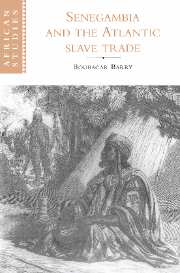Book contents
- Frontmatter
- Contents
- Preface
- Map
- I Senegambia from the fifteenth to the seventeenth century: a haven for incoming populations, a station for migrants on the move
- II Senegambia in the eighteenth century: the slave trade, ceddo regimes and Muslim revolutions
- 5 The slave trade in the eighteenth century
- 6 The strengthening of ceddo regimes in the eighteenth century
- 7 Muslim revolutions in the eighteenth century
- 8 The impact of the slave trade: economic regression and social strife
- III Senegambia in the first half of the nineteenth century: legitimate trade and sovereignty disputes
- IV Senegambia in the second half of the nineteenth century: colonial conquest and resistance movements
- Conclusion
- Notes
- Bibliography
- Index
- Other books in the series
7 - Muslim revolutions in the eighteenth century
Published online by Cambridge University Press: 31 October 2009
- Frontmatter
- Contents
- Preface
- Map
- I Senegambia from the fifteenth to the seventeenth century: a haven for incoming populations, a station for migrants on the move
- II Senegambia in the eighteenth century: the slave trade, ceddo regimes and Muslim revolutions
- 5 The slave trade in the eighteenth century
- 6 The strengthening of ceddo regimes in the eighteenth century
- 7 Muslim revolutions in the eighteenth century
- 8 The impact of the slave trade: economic regression and social strife
- III Senegambia in the first half of the nineteenth century: legitimate trade and sovereignty disputes
- IV Senegambia in the second half of the nineteenth century: colonial conquest and resistance movements
- Conclusion
- Notes
- Bibliography
- Index
- Other books in the series
Summary
The military defeat of the marabout movement led by Nasir Al Din in the latter half of the seventeenth century led, in many areas, to the development of underground Islamic movements opposed to ceddo regimes and the disastrous slave trade throughout Senegambia.
In various states controlled by powerul military aristocracies, Muslim communities under the leadership of highly influential families of marabouts built up their forces. They aimed, in gradual stages, to wrest political and social autonomy from existing regimes. Increasingly, at the same time, these Muslim communities, interlinked through far-reaching networks of religious, political, and economic solidarity that transcended state frontiers to cover the whole of Senegambia, tried either to create new states outright or to organize the violent seizure of established power by proclaiming a holy war.
Thus, right at the end of the seventeenth century, Malik Sy founded the Muslim theocracy of Bundu. This was followed, at the beginning of the eighteenth century, by the Muslim revolution in Futa Jallon led by Karamoko Alfa. Following Muslim successes in this borderline region of Senegambia, there was a lull until the second half of the eighteenth century before the triumph of the Toorodo group of Muslims led by the marabout Suleyman Bal in Futa Toro, the bastion of the Denyanke regime. This triple success testifies to both the continuity and the solidarity of the marabout movement throughout Senegambia.
- Type
- Chapter
- Information
- Senegambia and the Atlantic Slave Trade , pp. 94 - 106Publisher: Cambridge University PressPrint publication year: 1997

